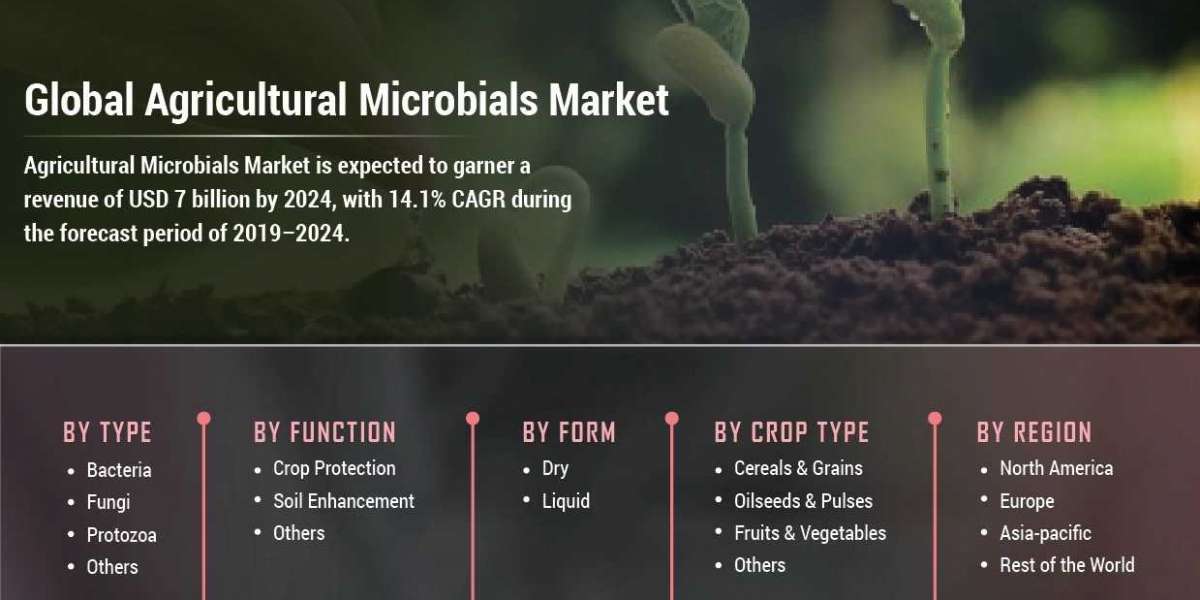Market Overview
Market Research Future (MRFR) projects the Agricultural Microbials Industry to garner a strong valuation of USD 7 billion by 2027. The market could attain 14.1% CAGR from 2020 to 2027.
Top Drivers and Challenges
Agricultural Microbials Industry can expect significant growth in the coming years. Agricultural microbial are the microorganisms that are used extensively in the agriculture sector for enhancing crop productivity as well as the quality of the yield. Microbial inoculants boast of target specific functions, and therefore, are ideally used in a variety of crops. Agricultural microorganisms are some of the naturally found substances including bacteria and molds that also provide nutrients like nitrogen and phosphorous to plants. Microbes are present in the soil and are closely associated with plants and both combined form microbiomes. Microbes such as fungi, virus, protists and bacteria, among others help bolster the plant’s growth by elevating access to supplements
Various microbes help decomposing organic matter, recycling of agricultural material, provide nitrogen or phosphorus as nutrients and offer benefits including drought and heat tolerance as well as resistance to diseases and insects. Agricultural microbials facilitate holistic improvement of plant health and augment crop productivity via economical solutions while curbing disease outbreaks, enhancing the soil health condition, and refining the overall nutrient transportation process.
The booming worldwide population, combined with the mounting uptake of sustainable agricultural practices along with the public concerns with regard to environmental safety augment the demand for the Agricultural Microbials Industry. Rise in the urbanization ate along with the declination in arable land are compelling farmers to take up effective crop-protection techniques. Given the broader acceptance as well as recognition of the many advantages of microbial products, the market value has been rising at a stunning pace.
Segmental Outlook
The Agricultural Microbials Industry has been considered for various segments, namely type, form, function, as well as crop type.
The types of agricultural microbials are protozoa, fungi, bacteria, and more.
With respect to function, the Agricultural Microbials Industry caters to crop protection as well as soil enhancement, and others.
Different forms in which agricultural microbials are generally available include liquid and dry. The highest demand in the market is generated for liquid microbial while the gaseous agricultural microbial segment can attain the fastest growth rate in the coming years.
The crop types on which microbials are used include fruits vegetables, oilseeds pulses, cereals grains, and others.
Regional Overview
North America will be reigning as the global leader in the Agricultural Microbials Industry, followed by Europe. Canada and the United States form the biggest markets in North America, given the vast population of renowned developers and the rising focus on sustainable agriculture. The region has a number of strict regulations that aim to protect the environment, compelling manufacturers to follow the sustainability trend and do the needful with respect to their products.
Asia Pacific should prevail as the fastest soaring market in the following years, backed by several macro-economic factors including rising availability of a variety of agricultural microbials. Another encouraging aspect can be the surging awareness among farmers about these products for use as a crop protection technique. Mounting number of players in the region in line with the availability of cheap labor would work in favor of the APAC market as well.
Europe remains a major consumer of agricultural microbials, thanks to the thriving agriculture sector, facilitated by high land availability as well as ideal weather conditions. With various agencies coming up with stringent regulations about the excessive deployment of soil protection chemicals, the adoption of organic farming practices is surging rapidly in the region. This also renders a tremendous impact on the Agricultural Microbials Industry in the region.
Read More About Report @ https://www.marketresearchfuture.com/reports/agricultural-microbials-market-5410
Leading Companies
BASF SE (Germany), Novozymes A/S (Denmark), Dow AgroSciences LLC (US), Italpollina Usa, Inc. (US), Sumitomo Chemical Company Ltd. (Japan), Bayer CropScience AG (Germany), Certis U.S.A. LLC (US), Mitsubishi Shoji Foodtech Co., Ltd. (Japan), XiteBio Technologies Inc. (Canada), Novagreen Inc. (Canada), Nufarm Ltd. (Australia), Verdesian Life Sciences, LLC (US), Syngenta AG (Switzerland), Koppert B.V. (Netherlands), Queensland Agricultural Seeds (Australia), are the leading developers of agricultural microbials active in the worldwide market.
NOTE: Our Team of Researchers are Studying Covid19 and its Impact on Various Industry Verticals and wherever required we will be considering Covid19 Footprints for Better Analysis of Market and Industries. Cordially get in Touch for More Details.
Contact us:
Market Research Future (part of Wantstats Research and Media Private Limited),
99 Hudson Street,5Th Floor, New York, New York 10013, United States of America








